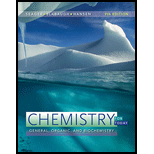
(a)
Interpretation:
The statements corresponding to the given formula that are equivalent to Statements 1-6 is to be stated.
Concept introduction:
The chemical formula of a compound represents the type of elements present in that compound. The subscript corresponding to that element represents the number of atoms of that element present in one molecule of that compound.
Answer to Problem 2.49E
The statements corresponding to
1. There are
2. There are
3. There are
4. There are
5. There are
6. There is
Explanation of Solution
For the given compound carbon dioxide
According to statement
According to statement
According to statement
According to statement
According to statement
According to statement
The statements corresponding to
1. There are
2. There are
3. There are
4. There are
5. There are
6. The
(b)
Interpretation:
The statements corresponding to the given formula that is equivalent to Statements 1-6 is to be stated.
Concept introduction:
The chemical formula of a compound represents the type of elements present in that compound. The subscript corresponding to that element represents the number of atoms of that element present in one molecule of that compound.
Answer to Problem 2.49E
The statements corresponding to
1. There are
2. There are
3. There are
4. There are
5. There are
6. There is
Explanation of Solution
The statements corresponding to
1. The
2. The
3. The
4. The
5. One mole of ethane
6. The
The statements corresponding to
1. There are
2. There are
3. There are
4. There are
5. There are
6. There is
(c)
Interpretation:
The statements corresponding to the given formula that is equivalent to Statements 1-6 is to be stated.
Concept introduction:
The chemical formula of a compound represents the type of elements present in that compound. The subscript corresponding to that element represents the number of atoms of that element present in one molecule of that compound.
Answer to Problem 2.49E
The statements corresponding to
1. There are
2. There are
3. There are
4. There are
5. There are
6. There is
Explanation of Solution
The statements corresponding to
1. The
2. The
3. The
4. The
5. One mole of glucose
6. The
The statements corresponding to
1. There are
2. There are
3. There are
4. There are
5. There are
6. There is
Want to see more full solutions like this?
Chapter 2 Solutions
Chemistry for Today: General, Organic, and Biochemistry
- Indicate the formula of the product obtained by reacting methyl 5-chloro-5-oxopentanoate with 1 mole of 4-penten-1-ylmagnesium bromide.arrow_forwardIn the two chair conformations of glucose, the most stable is the one with all the OH groups in the equatorial position. Is this correct?arrow_forwardIndicate the formula of the product obtained by reacting D-Galactose with hydroxylamine.arrow_forward
- helparrow_forwardThe temperature on a sample of pure X held at 1.25 atm and -54. °C is increased until the sample boils. The temperature is then held constant and the pressure is decreased by 0.42 atm. On the phase diagram below draw a path that shows this set of changes. pressure (atm) 2 0 0 200 400 temperature (K) Xarrow_forwardQUESTION: Answer Question 5: 'Calculating standard error of regression' STEP 1 by filling in all the empty green boxes *The values are all provided in the photo attached*arrow_forward
 Chemistry for Today: General, Organic, and Bioche...ChemistryISBN:9781305960060Author:Spencer L. Seager, Michael R. Slabaugh, Maren S. HansenPublisher:Cengage Learning
Chemistry for Today: General, Organic, and Bioche...ChemistryISBN:9781305960060Author:Spencer L. Seager, Michael R. Slabaugh, Maren S. HansenPublisher:Cengage Learning Chemistry: The Molecular ScienceChemistryISBN:9781285199047Author:John W. Moore, Conrad L. StanitskiPublisher:Cengage Learning
Chemistry: The Molecular ScienceChemistryISBN:9781285199047Author:John W. Moore, Conrad L. StanitskiPublisher:Cengage Learning Chemistry: Principles and PracticeChemistryISBN:9780534420123Author:Daniel L. Reger, Scott R. Goode, David W. Ball, Edward MercerPublisher:Cengage Learning
Chemistry: Principles and PracticeChemistryISBN:9780534420123Author:Daniel L. Reger, Scott R. Goode, David W. Ball, Edward MercerPublisher:Cengage Learning ChemistryChemistryISBN:9781305957404Author:Steven S. Zumdahl, Susan A. Zumdahl, Donald J. DeCostePublisher:Cengage Learning
ChemistryChemistryISBN:9781305957404Author:Steven S. Zumdahl, Susan A. Zumdahl, Donald J. DeCostePublisher:Cengage Learning





